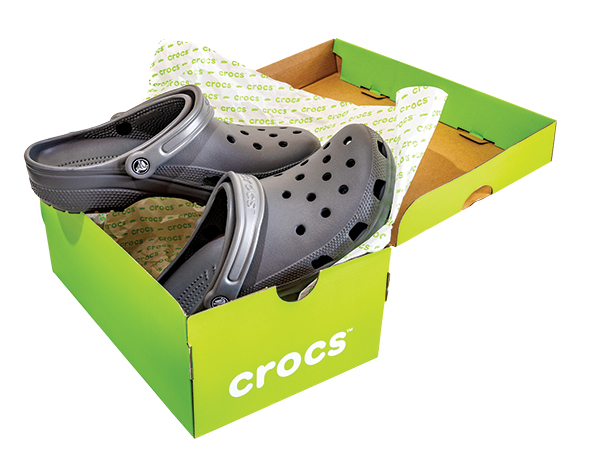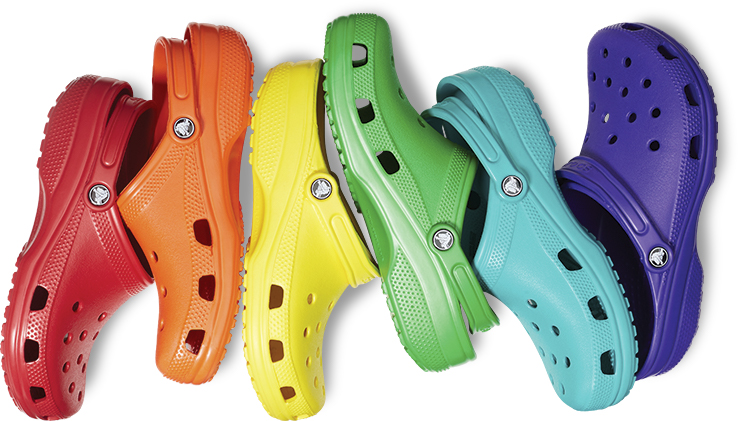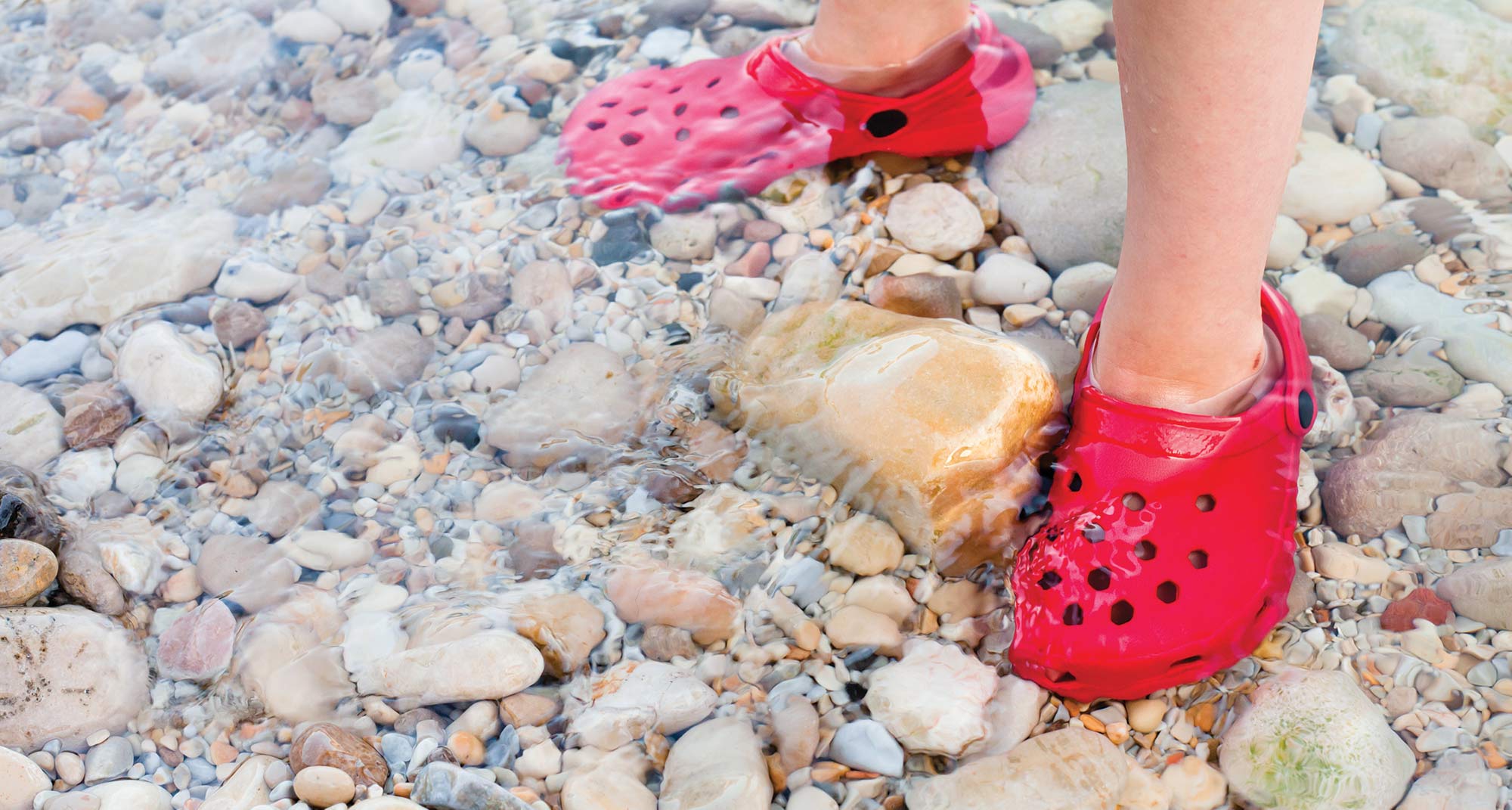Ugly Cool or Just Ugly?
A quick Google search for Crocs, the Colorado company that makes foam plastic footwear, yields a few disparaging, though comedic, headlines and a fair few memes. Some are downright hilarious, such as the one that reads “See those little holes? That’s where your dignity leaks out.”

Crocs has the last laugh
If annual financial reports are anything to go by, however, it would appear that Crocs is having the last laugh. In 2020, the company reported revenue of $1.4 billion, a 12.5 percent increase from 2019. There’s also plenty of empirical evidence to suggest that homebound folks were buying comfy Crocs online. The company’s digital sales—characterized as purchases via the company-owned website, third-party marketplaces, and e-tailers—rose by 50.2 percent in 2020. Those digital sales represented 41.5 percent of the company’s annual revenue. In 2019, digital sales were 31.1 percent of revenue. Direct-to-consumer sales increased 39.2 percent year over year as well.
COVID times have meant plenty of staying-at-home-and-working-in-sweats days, which seems to have been good business for Crocs and its comfort-driven footwear, born back in 2002. In a May 2020 story titled “Crocs Are Back in Style. And Not Just because of Coronavirus,” the Wall Street Journal says that some people think Crocs are “the perfect shoes to wear when no one can see you wear them.”
On the other hand—and this may come as a surprise to many who are not doctors or nurses—it seems as though plenty of (very important) people wear Crocs outside of hospitals, nursing homes, and, well, the secret cover of home. An October 2020 Vogue.co.uk article titled “Have You Got a Pair of Crocs Yet?” outlines the seemingly endless list of celebrities who have collaborated with, endorsed, and shared their love for Crocs of late. From Justin Bieber to Rihanna to Ariana Grande to Pharrell, Crocs are now cool. So cool that Bieber’s first collaboration model with the brand, which sold for $60, was fetching twice that price on eBay after the stock sold out in 90 minutes in October of 2020.

From a Meme to a Dream
Serving as Crocs’ Global Chief Marketing Officer until 2020, Terence Reilly knew full well when he stepped into the position seven years earlier that the product wasn’t exactly fashion-forward. It was an older generation and health-care professionals who were fans; most everyone else was poking fun. Still, Reilly saw the positive side of being the butt of many a joke. Smartly, he recognized that if Crocs footwear was so polarizing that people were motivated to make fun of it in a meme, it probably had a segment of the population on the other side of the coin that loved them just as much. Reilly led the brand’s resurgence with innovative marketing that included social media distinction and celebrity and brand collaborations.
“Everyone around the world knows the silhouette of the Crocs Classic,” Reilly explains. “So, what we needed to do was move from the awareness, which we had lots of, into really making the classic more relevant.”
Reilly is fond of saying that the company needed to go from being a meme to a dream, and that meant embracing the original clog rather than chasing what was trendy at the time. On Crocs.com, the Classic Clog takes center stage, with a call to action that urges visitors to “stand up and stand out.” The idea is to “Come As You Are”—to be comfortable in your own shoes, be inspired by the Crocs cast, and “make any Crocs style your own.”
It’s ironic that the original, straightforward Crocs footwear design is now marketed as a way to express oneself. How do you do that? By purchasing what are called Jibbitz—charms that cost four to six dollars on Crocs.com and can be affixed to your Crocs in order to personalize them. A potted plant that says, “Plant Lady,” letters to spell your name, animals, sports equipment, foods . . . you name it, you can stick it on your Crocs. The website calls them “Fun, symbolic and sentimental charms to represent your unique self to the world on your favorite pair of Crocs.”
While the brand work played a key role in Crocs’ renaissance and appeal to the Gen Z fandom, it’s fair to mention that some fortuitous timing was involved as well. As Crocs got back to basics, the fashion world began to trend toward comfort, and a new audience of teens (who had previously been difficult to reach) became a big driver for the brand. They were the consumers who wanted to fit in but also wanted to be different. The brand capitalized on this newfound comfort craze and refreshed its marketing to appeal to the younger consumer (especially younger females) by investing in celebrity endorsements and brand partnerships that, on the surface, might seem unlikely.
A collaboration with Kentucky Fried Chicken, featuring Crocs covered in a fried-chicken print, was one of its most prominent. That partnership was huge news in China, a positive step as Crocs looks to expand its business in that country through the use of PR agencies and carefully chosen celebrity endorsements. Media outlets are taking notice of these partnership plays. In March of 2021, Fast Company ranked Crocs number two in its list of “The 10 Most Innovative Joint Ventures of 2021.”
Celebrities, Fans, and Healthcare Workers Show Out on Social Media
On Instagram, Crocs has one million followers, and celebrities in Crocs litter the photo gallery. There are images of everyone from musicians such as Post Malone and Luke Combs to designers such as Nicole Mclaughlin and Anwar Carrots. There’s also plenty more Bieber, whose second Crocs collab in March of 2021 sold out in a matter of days. The brand doesn’t seem to take itself too seriously, sharing photos of people walking their dogs in Crocs or short videos of influencers flaunting their Crocs at home. And there is no shortage of product shots adorned with Jibbitz.
Much of the marketing is done by a recently expanded in-house team in Colorado, which has emphasized social media opportunities by closely monitoring Crocs-related conversations and reacting quickly to amplify them. On Twitter, the team constantly reacts to the Crocs-related posts of their fans, such as the one from a new bride who was photographed sharing a wedding-day kiss with her husband in her wedding gown and, you guessed it, bright-yellow Crocs. The brand is fully engaged with its community. On Crocs.com, members of the community can upload their photos from their photo libraries or Facebook, Instagram, or YouTube accounts to be used by Crocs.
What is unmistakable on Crocs’ social media channels, particularly Instagram, is the brand’s connection with healthcare professionals, who have shared numerous photos of themselves modeling their shoes at work. In 2020, the company showed that it has not forgotten this loyal segment of its audience by answering the call of frontline healthcare workers battling the COVID-19 pandemic. To meet their needs, Crocs developed a program called Sharing a Free Pair for Healthcare through which it provided free pairs of shoes to healthcare heroes around the world. Over the course of 45 days, the company distributed more than 860,000 free pairs, with a total retail value of more than $40 million. In March of 2021, when a mass shooting occurred in Boulder, not far from its headquarters, Crocs jumped into action again by donating to the Colorado Healing Fund.
Today, Crocs is offering athleisure models in the form of sneakers, sandals, and slip-ons that are lighter and softer than the classic model.
So, why do we love Crocs enough to feature them in our Brands We Love column? Crocs has successfully reinvented and modernized its marketing to appeal to multiple generations; the brand has collaborated with celebrities and out-of-the-ordinary brands; and its support of healthcare workers during the pandemic has been mind-blowing. And, you have to admit, there are those of us who once swore that we would not ever be seen wearing Crocs but are now finding them “ugly cool.” Coincidence or marketing genius?
”Over the course of 45 days, the company distributed more than 860,000 free pairs, with a total retail value of more than $40 million.







